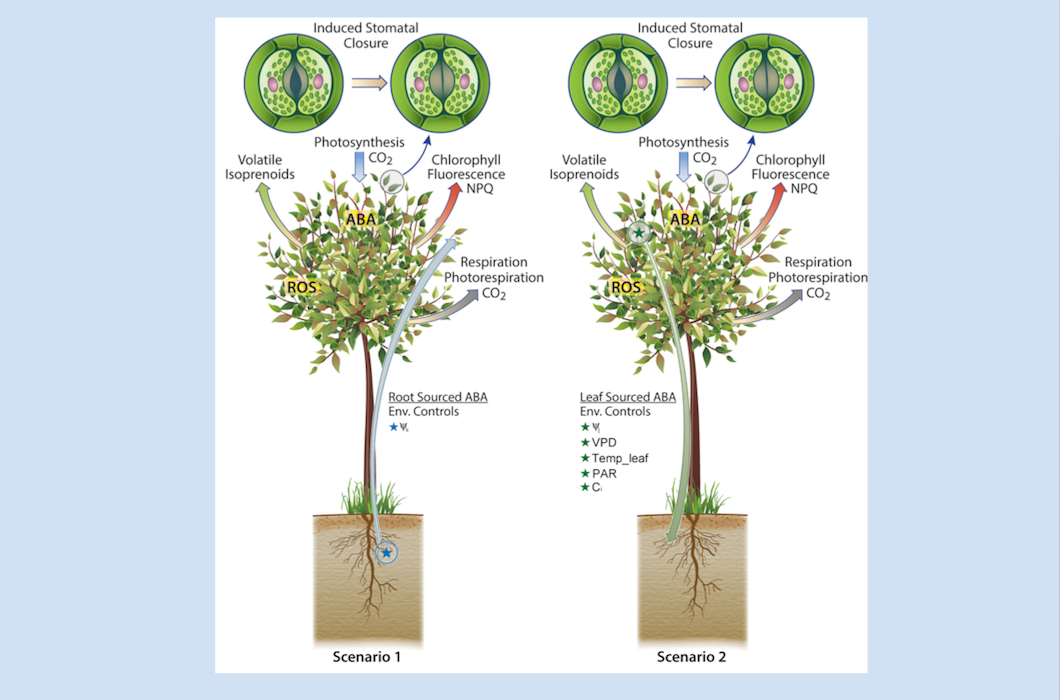Below versus above Ground Plant Sources of Abscisic Acid (ABA) at the Heart of Tropical Forest Response to Warming
Abscisic Acid mediates tropical forest response to warming
The Science
While assumed to be transported from roots to leaves where it controls transpiration and net photosynthesis by modifying stomatal conductance, we provide evidence that the powerful phytohormone abscisic acid (ABA) is produced mainly in leaves linked to photosynthesis (Scenario 2).

The Impact
We highlight the fact that ABA lies at the heart of tropical forest response to environmentally extremes by serving as a key endogenous factor that integrates oxidative stress and defense mechanisms, hydraulics, and carbon and energy metabolism with environmental variables. We discuss potential variations in ABA production and stomatal sensitivity among different plant functional types including isohydric/anisohydric and pioneer/climax tree species. We describe experiments that would demonstrate the possibility of a direct energetic and carbon link between leaf ABA biosynthesis and photosynthesis, and discuss the potential for a positive feedback between leaf warming and enhanced ABA production together with reduced stomatal conductance and transpiration. Finally, we propose a new modeling framework to capture these interactions.
Summary
Warming surface temperatures and increasing frequency and duration of widespread droughts threaten the health of natural forests and agricultural crops. High temperatures (HT) and intense droughts can lead to the excessive plant water loss and the accumulation of reactive oxygen species (ROS) resulting in extensive physical and oxidative damage to sensitive plant components including photosynthetic membranes. ROS signaling is tightly integrated with signaling mechanisms of the potent phytohormone abscisic acid (ABA), which stimulates stomatal closure leading to a reduction in transpiration and net photosynthesis, alters hydraulic conductivities, and activates defense gene expression including antioxidant systems. While generally assumed to be produced in roots and transported to shoots following drought stress, recent evidence suggests that a large fraction of plant ABA is produced in leaves via the isoprenoid pathway. Thus, through stomatal regulation and stress signaling which alters water and carbon fluxes, we highlight the fact that ABA lies at the heart of the Carbon-Water-ROS Nexus of plant response to HT and drought stress. We discuss the current state of knowledge of ABA biosynthesis, transport, and degradation and the role of ABA and other isoprenoids in the oxidative stress response. We discuss potential variations in ABA production and stomatal sensitivity among different plant functional types including isohydric/anisohydric and pioneer/climax tree species. We describe experiments that would demonstrate the possibility of a direct energetic and carbon link between leaf ABA biosynthesis and photosynthesis, and discuss the potential for a positive feedback between leaf warming and enhanced ABA production together with reduced stomatal conductance and transpiration. Finally, we propose a new modeling framework to capture these interactions. We conclude by discussing the importance of ABA in diverse tropical ecosystems through increases in the thermotolerance of photosynthesis to drought and heat stress, and the global importance of these mechanisms to carbon and water cycling under climate change scenarios.
Contacts (BER PM): Dan Stover, SC-23.1
PI Contact: Kolby J. Jardine, Lawrence Berkeley National Laboratory (LBNL), Climate and Ecosystem Sciences Division, kjjardine@lbl.gov
Funding
This material is based upon work supported as part of the Next Generation Ecosystem Experiments-Tropics (NGEE-Tropics) funded by the U.S. Department of Energy, Office of Science, Office of Biological and Environmental Research through contract No. DE-AC02-05CH11231 to LBNL, as part of DOE’s Terrestrial Ecosystem Science Program. Additional funding for this research was provided by the Brazilian Conselho Nacional de Desenvolvimento Científico e Tecnológico (CNPq).
Publications
Sampaio Filho I, Jardine K, Oliveira R, Gimenez B, Cobello L, Piva L, Candido L, Higuchi N, Chambers J (2018) Below versus above ground plant sources of abscisic acid (ABA) at the heart of tropical forest response to warming, International journal of molecular sciences, 19(7), 2023. http://dx.doi.org/10.3390/ijms19072023.